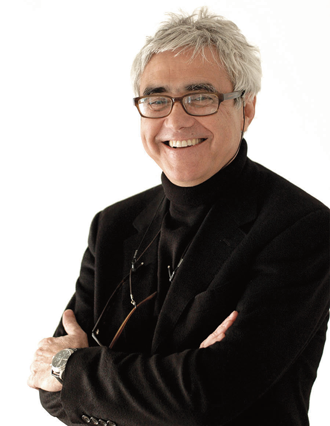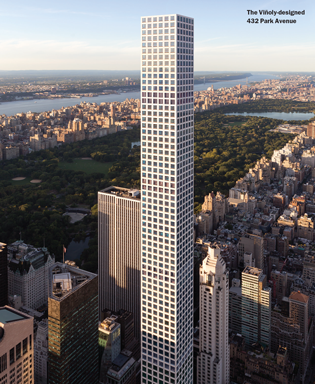Trending
Rafael Viñoly: The pragmatist of Park Avenue
The world-renowned architect talks to TRD about designing for the 1 percent and the industry’s ‘artist’ complex

There are few parts of Manhattan — or even the outer boroughs — where 432 Park Avenue, rising in all its geometric perfection, is not visible.
For that reason and others, it’s also become one of the most controversial buildings in the city. While this architecture critic sees beauty in the building’s radical, repetitive simplicity, some observers have criticized it for being too simple. To them, it is an unavoidable landmark that has forever altered — and even spoiled — the view down Park Avenue, as well as many other vistas. Most of all, they see it as an act of architectonic arrogance, incarnating the hubris of the 1 percent.
Not surprisingly, Rafael Viñoly, the world-renowned architect who designed the building, has a different perspective. He recently sat down with The Real Deal for a wide-ranging interview that hit on that, and on a slew of other topics facing the architecture industry today. (He also recently made some blunt remarks about some of the developers he’s worked with, but wrote a letter to the editor after the TRD and other news outlets published those comments. See related stories on page 72.)
Having covered New York City architecture for some years, I was familiar with Viñoly’s work, but it was in the context of writing my new book — “Buenos Aires: The Biography of a City” — that I came to understand that he was responsible for some of the most important buildings that have been erected in Argentina in the past four decades.
Viñoly — who was born in Uruguay in 1944 — moved to Buenos Aires when he was 5. And it was there that he achieved an architectural precocity that may be virtually unparalleled.
In the United States, and especially in New York, an architect is lucky if he builds anything by his mid-fifties. Viñoly was already working as an architect (and had begun making his mark on the Buenos Aires skyline) at age 20, after starting at the University of Buenos Aires’ architecture school when he was just 18. He quickly set himself apart by winning a design competition for a wood workshop. This won him the attention of some professors at the school who, he said, “asked me to come work with them.” From there, he told TRD, “other friends put together a series of jobs, and we started our office.”
By the 1970s, the firm — which went by the ungodly name of Estudio MSGSSS — was building some of the most important new architecture in Buenos Aires, both for private developers and for the government during the military dictatorship that ruled there in the late 1970s.
“I had a house and a boat; I was successful,” Viñoly recalled, from his elegant and minimalist offices at 50 Vandam Street, where his firm occupies an entire two-story building. “When I did all this work for the military, I had a military car, and there was a motorcycle with a siren in front of me wherever I went. I was 31, and I felt like a big shot.”
However, one day in the late 1970s he returned home to discover that the police had been snooping around his house. Viñoly had an epiphany. “I realized I was part of a fascist government. I suddenly understood that I had to leave.”
In 1978, he did just that.
Viñoly arrived in New York with his wife and their three sons, not knowing English and without a valid architect’s license. Still, he called it the “best thing I did in my life.”

432 Park Avenue
“New York City is the only really open place in the world: Not America, not London, but New York City,” he said. “Arriving here was like breaking into a party. You had to dance, but no one asked where you came from, where you studied. I have a debt of gratitude to this town that is immeasurable. The things that happened to me here would be impossible anywhere else.”
And that was despite arriving in the midst of the recession.
“Everything was for sale,” Viñoly recalled. “So I started calling people, people I knew in Argentina, and I said, ‘You have to buy a piece of land here.’”
He continued, “We built a 54-story tower; that was the first job I had, on 52nd Street between Sixth and Seventh avenues. I bought a site in the South Street Seaport area for another client. It’s still there. And then another on 93rd and Third, and [one] at Third Avenue and 54th Street, opposite CitiCorp.”
He also arranged for Francisco Macri, father of Mauricio Macri, the incumbent president of Argentina, to buy land he eventually sold to Donald Trump from 59th to 72nd streets on the Far West Side. That land ultimately became home to the string of towers now known as Trump Place. “He was completely creamed by Donald Trump,” Viñoly recalled, noting that Macri sold it for less than it was worth.
Viñoly has also designed a slew of other buildings and spaces in New York, including: the Brooklyn Children’s Museum; the Bronx Housing Court; the Frederick P. Rose Hall, which houses Jazz at Lincoln Center inside the Time Warner Center; and the Bronx County Hall of Justice.
When I asked Viñoly whether he had a favorite among his buildings, he cited a few from the above list, but the conversation quickly turned to 432 Park.
“Yes, it’s tall, and yes, it’s controversial. But wait until some of the others come on line [on 57th Street], and then you tell me. This is a discreet, restrained, simple, totally intelligent building,” he said.
“It has a quality of timelessness. Sometimes you just hit it right. And people notice it: not because it’s very tall, but because it’s good,” he added with a laugh.
He also noted that the building has a “logical structure that architects of late have forgotten or abandoned.”
That, he said, gives it a clear floor plan that allows owners to design their units however they wish. “Some of the new towers, some of them taller than this, are just forests of columns in their interior spaces,” Viñoly said.
Those clustered columns are just one of Viñoly’s criticisms of the current state of his industry. He traced many of today’s problems to the teachers of the past.
“The whole crisis that you now have in architecture is due to the fact that the people who taught in the ’70s and ’80s didn’t know shit — and had never built anything in their lives. … But then suddenly everyone who was raised in that philosophy wants to build, and when they do, they build badly.”
Viñoly went on to lament the “overgrowth” of consultants in the industry, which he attributed to architects failing to value engineer their own designs.
“If you, the architect, need an external group to value engineer your work, it’s because you don’t understand that your building has to be done with X amount of money,” he said. “Architects prefer to see themselves as artists, but … it’s not about art; it’s about the commission. Architects see those constraints as a limit — but they are not limits; they are the terms with which you have to do something. … If you assume all you do is move your feathers and you’re an artist, then I think you’re not an architect.”
Speaking of consultants, Viñoly said, “I remember a job not too long ago. We had even a color consultant. I know how to do that crap!”
When asked how he felt about seeing his buildings altered, he was surprisingly unfazed. And what if somebody decided to paint 432 Park pink? “There are far worse cases of collective stupidity than that. Buildings belong to the owners, and they can do whatever the hell they want with them.” I was surprised (and impressed) that Viñoly was so quick to take responsibility for the sales success of his work.
“If 432 had not been a commercial success, then I think we would have done it wrong.”
If the building fails commercially, he said, “it is my fault. I should have convinced the guy why he should do something else!”
I also asked Viñoly to address the plutocratic symbolism of 432 Park. “Income disparity,” he replied, “is a massive problem that you cannot address, and neither can I.
“Address that when you go vote, not when you’re at the drawing board,” he added. “The building addresses one part of the market that exists, whether you like it or not. Now the fact that it caters to the 1 percent, well, let’s elect Bernie, or Hillary, or the other creep, what’s his name?”
James Gardner is the architecture critic for TRD.




